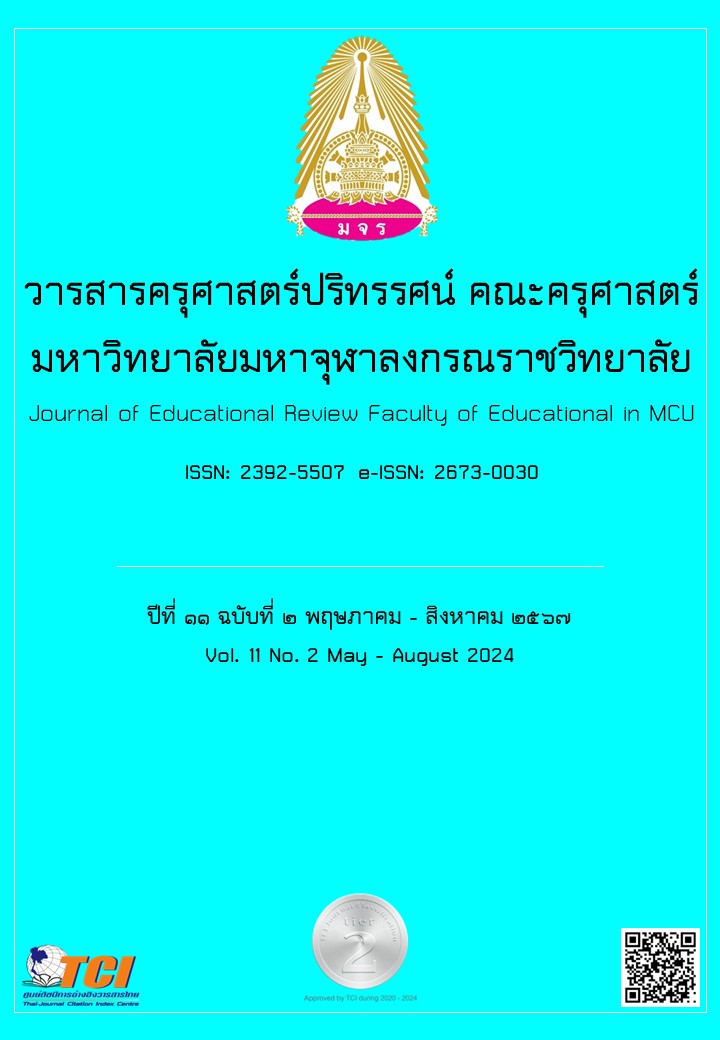DEVELOPMENT OF A KNOWLEDGE SET OF A MODEL OF DHAMMA TEACHING FOR BUDDHIST ELDERLY AND NEARLY DEATH PERSON APPEARED IN TIPITAKA
Main Article Content
Abstract
This research article aimed to; 1) study the elderly Buddhist disciples and those who were in a near-death state in the Tipitaka, 2) study the Dhamma teaching of elderly Buddhist disciples and those in a near-death state in the Tipitaka, 3) develop a knowledge set of a model of Dhamma teaching for elderly Buddhist disciples and those in a near-death state in the Tipitaka. This was qualitative research using documentary investigation and in-depth interviews with 15 key informants by document analysis and data collection through interviews, presented by content analysis. The research results found that; 1) The Elderly Buddhist disciples and those with a near-death state in the Tipitaka revealed that the teaching methods include discussion-based teaching, lecture-based teaching, problem-solving teaching, and rule-setting teaching. Examples of elderly disciples included Venerable Aññakoṇḍañña, Venerable Uruvelakassapa, Venerable Upāli, Venerable Kāludāyi, Venerable Mahākāccāyana, Venerable Sāriputta, Venerable Mahākassapa, Venerable Rāhula, Venerable Vaṅgīsa, Venerable Sobhita, and Venerable Mahāmoggallāna. Examples of those in a near-death state include Venerable Pūtigattatissa, Venerable Vakkali, Venerable Uttarā Therī, and story of Bhikkhu afflicted with severe distress and wished to disrobe. 2) The teaching of elderly Buddhist disciples and those in a near-death state in the Tripitaka indicated that the Buddha taught systematically with principles, content, techniques, and media, leading the disciples to enlightenment in final. These disciples played significant roles for spreading Buddhism and understanding death as a natural law according to the Three Characteristics: impermanence, suffering, and non-self. The Buddha taught the disciples to cultivate mindfulness through Buddhist meditation practices. Examples include Venerable Pūtigatta Tissa, Venerable Vakkali, Venerable Uttarā Therī, and a distressed and emaciated Bhikkhu who wished to disrobe. 3) The development of a knowledge set of a model of Dhamma teaching for elderly Buddhist disciples and those in a near-death state in the Tipitaka was found that (1) Teaching principles were based on current realities, (2) Content appropriate to the age, the teacher and the situation, (3) Teaching methods such as lectures, discussions, Q&A, and practice, (4) Teaching techniques tailored to the temperament and needs of the learners, (5) Teaching materials included utilizing both natural and modern media, suitable for individuals, and including activities of mindfulness investigation, and (6) Evaluation methods must focus on real-life outcomes to improve the effectiveness of teaching elderly disciples and those in a near-death state, enabling them to achieve enlightenment before death.
Article Details

This work is licensed under a Creative Commons Attribution-NonCommercial-NoDerivatives 4.0 International License.
ทัศนะและความคิดเห็นที่ปรากฏในบทความในวารสารฉบับนี้ถือเป็นความรับผิดชอบของผู้เขียนบทความนั้นเพียงผู้เดียว และไม่ถือเป็นทัศนะและความรับผิดชอบของกองบรรณาธิการ
กองบรรณาธิการขอสงวนสิทธิ์ในการคัดเลือกบทความลงตีพิมพ์และจะแจ้งให้เจ้าของบทความทราบหลังจากผู้ประเมินบทความตรวจอ่านบทความแล้ว
ต้นฉบับที่ได้รับการตีพิมพ์ในวารสารครุศาสตร์ปริทรรศน์ คณะครุศาสตร์ มหาวิทยาลัยมหาจุฬาลงกรณราชวิทยาลัย ถือเป็นกรรมสิทธิ์ของคณะครุศาสตร์ มหาวิทยาลัยมหาจุฬาลงกรณราชวิทยาลัย ห้ามนำข้อความทั้งหมดหรือบางส่วนไปพิมพ์ซ้ำ เว้นเสียแต่ว่าจะได้รับอนุญาตจากมหาวิทยาลัยฯ เป็นลายลักษณ์อักษร
References
ขวัญตา บาลทิพย์. (2541). ประสบการณ์การรับรู้เกี่ยวกับความตายของผู้ป่วยเอดส์ณ วัดแห่งหนึ่งในภาคใต้. วิทยานิพนธ์พยาบาลศาสตร์มหาบัณฑิต. มหาวิทยาลัยสงขลา.
นุจรินทร์ ลภัณฑกุล. (2543). ประสบการณ์ดูแลผู้ป่วยใกล้ตายของพยาบาล. วิทยานิพนธ์พยาบาลศาสตรมหาบัณฑิต. มหาวิทยาลัยบูรพา.
พระพรหมคุณาภรณ์ (ป. อ. ปยุตฺโต). (2550). การแพทย์ยุคใหม่ในพุทธทัศน์. พิมพ์ครั้งที่ 5. กรุงเทพมหานคร: สหธรรมิก.
พระมหาปองปรีดา ปริปุณฺโณ (จำปาศรี). (2545). การป้องกันและการรักษาโรคตามหลักพระพุทธศาสนา. วิทยานิพนธ์พุทธศาสตรมหาบัณฑิต. มหาวิทยาลัยมหาจุฬาลงกรณราชวิทยาลัย.
พระมหาวันชัย ธมุมชโย. (2540). การศึกษาเชิงวิเคราะห์เรื่องความตายตามทัศนะของพุทธทาสภิกขุ.วิทยานิพนธ์พุทธศาสตรมหาบัณฑิต.: มหาวิทยาลัยมหาจุฬาลงกรณราชวิทยาลัย.
พระวรศักดิ์ จนฺทโชโต. (2542). การศึกษาจริตกับการรับรู้ความตาย:กรณีศึกษาผู้ปฏิบัติวิปัสสนากรรมฐาน วัดระฆังโฆสิตาราม. วิทยานิพนธ์พุทธศาสตรมหาบัณฑิต. มหาวิทยาลัยมหาจุฬาลงกรณราชวิทยาลัย.
มหาจุฬาลงกรณราชวิทยาลัย. (2539). พระไตรปิฎกภาษาไทย ฉบับมหาจุฬาลงกรณราชวิทยาลัย, กรุงเทพมหานคร: โรงพิมพ์มหาจุฬาลงกรณราชวิทยาลัย.
อุทยา นาคเจริญ. (2544). การเตรียมตัวสำหรับความตายของผู้ติดเชื้อเอชไอวี. วิทยานิพนธ์พยาบาลศาสตรมหาบัณฑิต. มหาวิทยาลัยเชียงใหม่.


